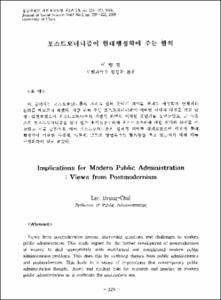英語의 超分節音素의 硏究
- Alternative Title
- A Study of English Suprasegmental Phonemes
- Abstract
- 超分節音素(Suprasegmental Phoneme)는 分節音素(Segmental Phoneme)와 마찬가지로 對立되고 또 變異音(Allophone)을 가지고 있어서 文章의 意味의 區別을 가져오는 音素로 取扱된다. 兩者는 相補的인 立場에 놓여 있어 이들이 서로 合하여야 비로소 言語의 構成이 가능하게 되는 것이다.
初分節音素를 形成하는 强勢(Stress)와 連接(Juncture) 그리고 音度(Pitch)는 각자 獨立的인 機能을 가지고 있으면서도 複雜하게 서로 얽혀 있다.
이들은 대체?? 各各 4個의 等級을 가지고 있는데, 强勢로서는 第一强勢(Primary Stress):/'/를 비롯해서 Secondary:/^/, Tertiary:/`/, 그리고 Weak:/ˇ/(또는 無旗號)가 있으며 連接은 內開連接(Internal Open Juncture);/+/과 3個의 末尾連接
/,
/,/#/으로 되어 있다. 또한 음도로서는 초고음도(Extra High Pitch):/4/와 함께 High:/3/, Mid:/2/, 그리고 Low:/1/가 있다.
"greenhouse"와 "green hous"는 連接을 가정하지 않고도 house의 强勢가 weak에서 strong으로 바뀜으로써 意味의 差異를 가져오며, "an aim"과 "a name"은 오직 /+/ juncture에 依하여 各各 / n+eym/과 / +neym/으로 그 뜻이 區別되니 이로 보아 stress와 juncture은 音素라는 것이 證明된다.
또한 말소리의 高低를 나타내는 pitch없이는 言語가 存在할 수 없으며, 이 pitch level의 基準은 言語的 差異를 決定짓는 基礎가 되고 있다.
强勢는 內開連接과 함께 强勢形(Stress Pattern)을 形成하며 音度는 3個의 末尾連接과 함께 音調型(Intonation Pattern)을 形成한다. 이와같이 超分節音素를 이루고 있는 强勢와 連接 그리고 音度는 各各 獨立的인 音素로서 서로 密接한 關係를 가지고 있음을 알 수 있다. 따라서 單語와 句의 構造를 明示하는 强勢型과 節이나 文章의 構造를 說明하는 音調型의 正確한 習得은 完全한 英語의 音聲組織이나 構造를 把握하는 捷徑이 될 것이다.
Stress, juncture and pitch are the three recognized suprasegmental phonemes. There are allophonic variations of them, just as there are allophones of consonants or vowels. We do not speak without them; English is alwasys heard with them. All are interdependent in English although each has distincive features separately.
As meaningful units of English, the combined segmental phonemes are spoken with degrees or levels of the suprasegmental phonemes of stress, pitch, and juncture. Linguists use the symbols /',^,`,ˇ/ to represent primary, secondary, tertiary, and weak stress, respectively. Linguistic analysis recognizes internal open juncture with a plus sign, /+/ and three terminal junctures with symbols of a single bar
/, double bar
/, and double cross /#/, Linguists also use /1/ for low, /2/ for id, /3/ for high, and /4/ for extra high in numbering the pitch phonemes.
Such phrases as "greenghouse(the plant-house)" and "green house (a colored house)" are sufficient to point out the relative stress differences. A contrast of another sort may be discovered through comparing "an aim" with "a name". We can distinguish these words with a /+/ juncture after / n/ and / /, respectively. Since its presence or absence may result in a minimal contrast between otherwise similar groups of phonemes, it belongs with the other suprasegmental phonemes of English.
We know that there is a close relationaship between stress and pitch as changes in the levels of stress are normally accompaied by changes in pitch levels.
The four pitches and three terminal junctures constitute intonation contour, whereas stress pattern is composed of stress and internal open juncture. The acquirement of these two patterns will therefore be the royal road to the study of English sound system.
Stress, juncture and pitch are the three recognized suprasegmental phonemes. There are allophonic variations of them, just as there are allophones of consonants or vowels. We do not speak without them; English is alwasys heard with them. All are interdependent in English although each has distincive features separately.
As meaningful units of English, the combined segmental phonemes are spoken with degrees or levels of the suprasegmental phonemes of stress, pitch, and juncture. Linguists use the symbols /',^,`,ˇ/ to represent primary, secondary, tertiary, and weak stress, respectively. Linguistic analysis recognizes internal open juncture with a plus sign, /+/ and three terminal junctures with symbols of a single bar
/, double bar
/, and double cross /#/, Linguists also use /1/ for low, /2/ for id, /3/ for high, and /4/ for extra high in numbering the pitch phonemes.
Such phrases as "greenghouse(the plant-house)" and "green house (a colored house)" are sufficient to point out the relative stress differences. A contrast of another sort may be discovered through comparing "an aim" with "a name". We can distinguish these words with a /+/ juncture after / n/ and / /, respectively. Since its presence or absence may result in a minimal contrast between otherwise similar groups of phonemes, it belongs with the other suprasegmental phonemes of English.
We know that there is a close relationaship between stress and pitch as changes in the levels of stress are normally accompaied by changes in pitch levels.
The four pitches and three terminal junctures constitute intonation contour, whereas stress pattern is composed of stress and internal open juncture. The acquirement of these two patterns will therefore be the royal road to the study of English sound system.
- Issued Date
- 1980
- Type
- Research Laboratory
- Alternative Author(s)
- Ryu, Sung Ryul
- Publisher
- 연구논문집
- Language
- kor
- Rights
- 울산대학교 저작물은 저작권에 의해 보호받습니다.
- Citation Volume
- 11
- Citation Number
- 2
- Citation Start Page
- 343
- Citation End Page
- 357
- Appears in Collections:
- Research Laboratory > University of Ulsan Report
- 파일 목록
-
-
Download
 000002024971.pdf
기타 데이터 / 1.26 MB / Adobe PDF
000002024971.pdf
기타 데이터 / 1.26 MB / Adobe PDF
-
Items in Repository are protected by copyright, with all rights reserved, unless otherwise indicated.